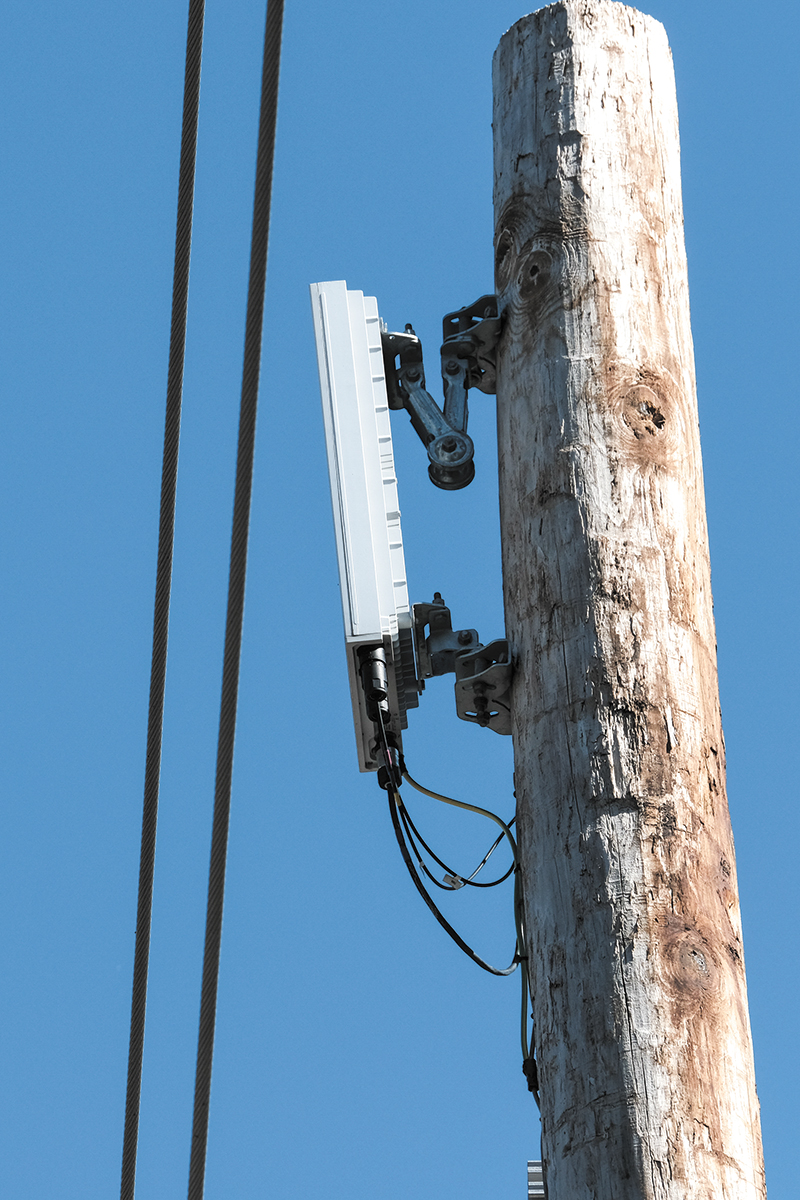Subscriber Benefit
As a subscriber you can listen to articles at work, in the car, or while you work out. Subscribe NowTelecom companies are putting 5G antennas by the hundreds in neighborhoods across Indianapolis, escalating tensions with residents who complain they have little say over where they’re built.
The small towers will enable AT&T, Verizon and other providers to blanket the region with wireless 5G service, which is faster and more reliable than the prior technology, 4G LTE, and can support automated cars and other innovations.
Workers have installed more than 350 poles, or small cell towers, in Indianapolis neighborhoods and other non-residential locations in the past five years. Hundreds to thousands more are in the works.
5G relies on many nodes of small antennas rather than the far fewer and much larger cell towers of past wireless generations. The greater the concentration of poles, the stronger the 5G signal.
Federal and state laws, including a measure passed by the Generally Assembly in 2018, generally handcuff municipalities in regulating the installation of the poles—as long as they meet general zoning standards and are in rights of way or other city-owned areas.
The only time a variance is required is when poles are proposed on residential or certain commercially zoned properties.


The leeway granted telecom companies contrasts sharply with the strict process homeowners must follow to make changes on their properties, said Chelsea Marburger, executive director of the Meridian-Kessler Neighborhood Association.
“Our first and foremost concern is that they [should] have to follow the same process we do,” she said. “We don’t think it’s fair or right for corporations to not have to follow that same process. If you were going to build something that required a variance, you would have to provide plans to the inch. [Telecom firms] only have to provide plans with approximate addresses.”
Residents of suburban counties also have raised concerns about the towers, as IBJ chronicled in a 2019 story. The controversy is gaining steam in Indianapolis now in part because of the deluge of requests filed by telecom companies in recent months.
On Oct. 20 alone, the Indianapolis Board of Zoning Appeals is expected to hear nearly 20 cases related to planned Verizon 5G poles in neighborhoods across the city; each carries anywhere from two to 10 addresses in the same general area.
Another 13 petitions for Verizon poles—also carrying multiple addresses—were heard during a separate zoning board meeting on Oct. 6, with most continued to a special meeting scheduled for Oct. 27.
Verizon said during the meeting that workers already have erected more than 950 nodes with 4G and 5G technology in Indianapolis, including areas not requiring zoning variances, such as downtown and in commercial and industrial areas.
About 310 permit requests remain open with the city, awaiting review. And 20 poles have been installed in Indianapolis this year, according to the city data, with permits issued for another 600.
 Petition
Petition
Meridian-Kessler’s Marburger was among six people to sign a letter to city officials in September that called for the city to be more transparent and stringent in awarding permits for new poles.
The other signers were city-county councilors John Barth and Keith Potts; Colleen Fanning, executive director of the Broad Ripple Neighborhood Association; Bryan Bradford, Butler-Tarkington Neighborhood Association board president; and Matthew Albaugh, Meridian-Kessler Neighborhood Association board president.
In addition to requesting exact addresses, the letter called for telecom companies to take “exhaustive measures” to place antennas on existing poles or in alleyways, rather than on new poles, and to provide more notice—at least 48 hours—to homeowners when installing a pole.
It also asked that telecommunications firms be required to meet with neighborhood groups as part of the zoning process.

In a written response, Rusty Carr, interim Department of Metropolitan Development director, said, “Wireless providers are held to the same standards as any homeowner making a variance request.”
He also said state law bars cities from regulating the installation of wireless technology on existing infrastructure. But, he added, if firms apply for a new pole, they have to say why they can’t locate on an existing one.
5G blitz
Verizon launched its 5G home service in parts of Indianapolis in October 2019, but customers must have a 5G-enabled device to use it. In a lengthy statement responding to questions from IBJ about the deployment of its network, Verizon said “the locations selected reflect technical and engineering needs,” and altering those plans could hinder the network’s effectiveness.
“Due to technical constraints, we cannot put these facilities just anywhere in a neighborhood,” the statement said. “A change in placement can significantly impact the functioning of a small cell as well as the larger network. Given the propagation characteristics of a wireless signal, we’re also designing around trees, buildings and other obstructions that can impact network performance.”
The company cited those issues as reasons why it’s not always feasible to place poles in alleys or to co-locate them with other providers—although Verizon said it is open to that option when it can be done.
AT&T also has installed dozens of poles across Indianapolis over the past few years. It didn’t respond to requests for comment.

Matt Pleasant, the Department of Metropolitan Development’s planning director, said most residents voicing concerns about new poles have said they are comfortable with 5G technology but are frustrated with the approval process or where poles are being installed.
“The consensus that I gather is, people are not necessarily against 5G—they’re not against the poles themselves—but they don’t like the placement,” he said. “They don’t like how they look and don’t want them in front yards. They feel like it’ll lessen their property values.”
More than 80 remonstrators spoke during the Oct. 6 hearing—many expressing concerns over placement, lack of notification about the zoning variance process, and property values.
Some expressed opposition to the towers and a desire for the antennas to be placed underground, as other utilities often are.
Studies have not conclusively linked the installation of 5G nodes with the lowering of property values or health concerns.

Saurabh Bagchi, a Purdue University School of Engineering professor and expert in communication technologies, said he isn’t surprised by the pushback, but said people should expect to see far more small-cell towers built in residential and suburban areas over the next several years.
Amid that boom, Bagchi said, “each municipality will have to make the decision whether they’re going to allow the abundance of poles, in the locations desired, or if they’re going to have a bit of a compromise.” He said cities could risk their futures if they try to push away 5G efforts, but it’s too soon to know for sure.
The DMD’s Carr said DMD and the Department of Business and Neighborhood Services want to ensure the public has a voice in determining the fate of poles.
“Certainly, the city is supportive of 5G,” he said. “We just want it to be responsibly done in partnership with neighborhoods.”
But he noted that, once a company files for a pole permit, the city has only 90 days to complete due diligence and finalize approvals. If that doesn’t happen, the request is approved automatically. “This public hearing process is important, to make sure that those voices are heard during this variance process.”•
Please enable JavaScript to view this content.


Who does the research for IBJ’s articles? I have complained about 5G installation for at least two years since they installed them on 86th Street. According to your article “Matt Pleasant, the Department of Metropolitan Development’s planning director, said most residents voicing concerns about new poles have said they are comfortable with 5G technology but are frustrated with the approval process or where poles are being installed”.
Five or ten years ago, the states gave up their control of call/internet/ & telephone to the Federal Government. These providers can do what ever they want, and wherever they want. Try to call the state about your problem with where these poles are installed; and you will find that no state agency has any say about anything. Verizon installed 5G nodes along 86th and nothing was regulated. There is no way to complain to Verizon, if you don’t have a Verizon phone number, your call is unplugged. Their “crew” turned out to be a Verizon subsidiary out of North Carolina, the truck according to Indiana DOT records was only supposed to work in Tennessee. The “crew” was from Kentucky. Indiana had no say over this. They drove over and rutted 600 feet of my “right of way”. I pointed this out and the “crew” simply laughed at me. It wasn’t until I posted 20+ photos on their damage on Verizon’s FB’s page did I get a reaction and a check for $900 to fill in the ruts.
Why these companies can not work together and put up one pole that is out of sight is beyond me. Google “the dangers of 5G” and you will learn that the FCC has not studied or approved this technology; nor are they required too. I think it’s dangerous, we are all lab rats. AT&T took down their never fail copper wires to change it out with FIOS. I had to throw away all of my old phones and install a new security system because the old ways are not compatible with the new stuff. They will not “handshake” with FIOS, so they just stop working. These companies all want to provide internet and cable along with phone service; we are stuck with the bills; and I doubt if it will be as reliable as the old copper wires.
The other reason all these poles are sprouting everywhere is that IPL’s poles can only carry so much weight. If the weight (including snow & ice covered) are close to harming the pole, new wires can not be included on the pole. So, new pole arise.
Anyone with any sense can see these 5G devices are sitting ducks. Worldwide, they are being vandalized or cut down. One bullet can disable the whole pole. Most have wires near the ground that can easily be cut. If you want to paralyze modern society, this may be the easiest way. This is a replay the government’s way to get people to switch to those lousy LED bulbs and making reliable television viewers to throw away their televisions and subscribe to cable.
The IBJ needs to do it’s homework better than this piece of propaganda. 5G is no panacea. Steven Pettinga (subscriber).
You are worried about 5g? Do you have tinfoil hats at home too? If your system wont handshake then at least make sure you and your family have night time surveillance for the black helicopters that might be overhead. While you are at it, make sure to look out for the green men practicing ‘military exercises.’
“remonstrators”. Someone got a new thesaurus!
Odd comment regard 5G pole location with respect to trees. What are the parameters locating for 5G poles. And, do property owner or the city have options to address the aesthetics of these poles with respect to current development and historic structures and areas.
North Willow Farms is Indianapolis’s first, master planned community. One of the features baked in to the neighborhood’s creation was all underground utilities. So to have Verizon show up unannounced to install above the ground poles was not a shock.
Like was mentioned as a neighborhood we are not opposed to 5G. We wish more transparency and inclusiveness went into tower placement. I would happily allow one in my back yard. My front yard not so much. They could have accomplished the same level of coverage without the sneak attack.
Is there a reason why these companies can’t share poles for these utilities? Why can these not be put on existing power poles??? Yes, I realize IPL would need to authorize use, but can we not work together to eliminate some of the eye pollution? We all want progress, but not unplanned/poorly planned infrastructure crammed down our throats!